-
Publish Your Research/Review Articles in our High Quality Journal for just USD $99*+Taxes( *T&C Apply)
Offer Ends On
Tumisang Richard Molata*, Poloko Mosebi, Oluwabiyi Ikeolu Atanda Oluremi and Setsumi Molapo
Corresponding Author: Tumisang Richard Molata, National University of Lesotho, Faculty of Agriculture, Department of Animal Science, P.O. Roma 180, Lesotho, South Africa.
Received: June 11, 2023 ; Revised: June 13, 2023 ; Accepted: June 16, 2023 ; Available Online: June 22, 2023
Citation: Molata TR, Mosebi P, Oluremi OIA & Molapo S. (2023) The Effects of Intercropping Maize with Selected Forage Legumes Under Different Tillage Practices in the Foothills of Lesotho. J Agric For Meterol Stud, 2(1): 1-5.
Copyrights: ©2023 Molata TR, Mosebi P, Oluremi OIA & Molapo S. This is an open-access article distributed under the terms of the Creative Commons Attribution License, which permits unrestricted use, distribution, and reproduction in any medium, provided the original author and source are credited.
Views & Citations
Likes & Shares
The study was contacted to assess the effects of tillage and cropping methods on the growth response of maize and selected forage legumes. The experiment was done in three replications using a split-plot design. The main plot treatments consisted of sole cropping and intercropping. The subplot treatments consisted of two tillage depths: minimum tillage [0.2 m] and deep tillage [0.35 m]. Cereal maize and selected forage legumes under minimum tillage and sole cropping resulted in to low plant development. Whereas, maize and forage legumes intercropped under deep tillage resulted in to highest plant height [P< 0.05]. Moreover, highest vegetative qualities in terms of leaf and stem lengths [P< 0.05] were recorded both in maize and forage legumes intercropped under deep tillage. As a result, to promote better plant growth, maize and forage legumes may be intercropped to obtain high forage yield.
Keywords: Agronomic practices, Maize, Soybean, Lablab, Plant yield
INTRODUCTION
Conservation agriculture has helped Lesotho's traditional subsistence farmers to produce more food and enhance agricultural productivity. In Lesotho, a developing nation, intercropping of cereals and legumes is regarded as a normal planting method [1]. Intercropping is a type of multiple cropping techniques that has historically been utilized by small-scale farmers. Legumes like beans and soybeans are among the crops that are regarded as both supplemental and staple crops in Southern Africa [2]. One geographically unique strategy that significantly boosted soil fertility and reduced soil erosion was intercropping. Some legumes and cereal maize were among the crops grown the most, primarily through intercropping [1].
The basic goal of intercropping is to maximize total productivity per unit of time and space while also making wise and equitable use of available resources, such as labor and land, and providing insurance against crop failure [3]. In recent studies, Dahmardeh [4] demonstrated that intercropping cereals and legumes increased plant production. Intercropping legumes with cereals also produced more superior quality organic matter inputs and increased productivity gains when compared to continuous maize mono-crops [5]. Legumes' capacity to fix atmospheric nitrogen or nitrogen discharged from their nodules into the soil benefits neighboring plants [6]. Alternately, legumes could provide fixed nitrogen, a crucial mineral nutrient, to intercropped cereals during their combined growth cycle [7].
Tillage, however, also has a significant impact on crop productivity. According to Sakthivel [8], tillage has a beneficial impact on crop development by improving photosynthesis, nitrogen uptake, and water conservation. Tillage also increases the amount of organic matter in the soil, the mobility of less mobile nutrients closes to the active root zone, and appropriate soil biological activity. Similar conclusions were also made by Mukherjee [9], who noted that tillage procedures improved cereal and legume growth. However, due to recent population increase, bad farming practices like overgrazing and continuous cropping, as well as natural factors like compaction and erosion, crop productivity on agricultural land has been significantly reduced [6]. Furthermore, excessive inorganic fertilizer uses diminished soil fertility, which in turn resulted in lower crop yields. As a result, the study's objective was to assess the results of intercropping maize with particular forage legumes under various tillage methods.
MATERIALS AND METHODS
Study site
The research was carried out in the Lesotho Foothills in Ha-Matela in Nazareth, east of Maseru. Nazareth is located at latitude 29°23′55.79′S and longitude 27°48′15.48′E, or about 1842 meters above sea level. During growing season monthly, average temperature was 22.5°C [with a minimum temperature of 19.76°C and a high temperature of 26.45°C]. The minimum monthly rainfall was 5.66 ml and the maximum were 57.24 ml.
Experimental design
Three replications of a split-plot design were used for the experiment. Two cropping systems, sole cropping and intercropping, were the primary plot treatments. Two tillage depths of minimum tillage [0.2 m] and deep tillage [0.35 m], labelled as M and D, respectively, made up the subplot treatments. Thus, the treatment combinations were M-Inter [Minimum tillage + Intercropping], D-Inter [Deep tillage + Intercropping], DS [Deep tillage + Sole cropping] and MS [Minimum tillage + Sole cropping]. Each plot was 30 m × 16 m in size, and soil preparation was done with a mouldboard plough.
Land preparation
A moldboard plough was used to prepare the experimental field, and it was harrowed to thin the soil. A soil sample was taken, and it’s physical, chemical, and mineral composition was all examined. Before seeding, a soil sample was taken using an auger from the top 0.15 to 0.15 meters of the soil surface. To determine the initial soil physiochemical parameters of the experimental field, the sample was air dried before analysis. A glass beaker containing 10 ml of distilled water and 5 g of air-dry soil was used. Glass rod was properly included into the mixture before standing the mixture for 30 min. The soil pH was measured with the EQUIP-TRONICS Digital pH meter model EQ-610. The soil sample was digested on Labcon digester at 300°C in a mixture of hydrogen peroxide, sulphuric acid, selenium and salicylic acid. The digest was analyzed for P, K, Fe, Zn, Cu and Mn. The total N content in the digest was obtained through Kjeldahl method.
Planting of forage seeds
Maize [Zea mays L] together with selected legume species lablab [Lablab purpureus L], grazing vetch [Vicia villosa] and soybean [Glycine max L] were planted. Planter was used to sow two maize seeds per hole, spacing them 0.25 meters apart and planting them 0.05 meters deep. Broadcasting was used to plant the legume species. For maize and forage legumes, 12.5 kg of inorganic nitrogen, phosphorus, and potassium [NPK] fertilizer was used per plot. Five weeks into the growth cycle of the plant, weeds were manually managed.
Sample gathering for aspects of forage growth
Plant height
A Pasture disc meter was used to measure the plant height of the forage legumes and the maize on a weekly basis with three replications in each treatment. Plant height was recorded after germination and throughout the growing stage of randomly selected plants. The disc was raised over the selected plant in order to obtain a reading.
Plant density
When calculating the distance between a sample point and the closest point, the point-centered quarter method was utilized. For all the cereal and some chosen legumes, plant density was assessed in each of the four quadrants or quarters around the spot.
Vegetative growth characteristics
Leaf length and stem length were measured as indicators of vegetative growth. At maturity, five plants were randomly selected from each plot. Five plants on average were used to determine the average length of the leaves and stems per plant. A measuring tape was used to gauge the length of the leaf and stem.
Data Analysis Section
A Microsoft Excel spreadsheet was used to manually enter the acquired data, which was then imported for analysis into SPSS [2012] version 20.0. A general linear model [GLM] was used to assess how tillage and cropping techniques affected the development of cereal maize, as well as the legume crops soybean, lablab, and grazing vetch. 95 percent confidence level was maintained for all analyses, and a P value of less than 0.05 was regarded as significant.
RESULTS AND DISCUSSION
As shown in Table 1, the plant height of maize obtained from cropping systems and tillage approaches differed significantly [P<0.05]. Under deep tillage, maize intercropped with legumes produced the tallest plants. The lowest plant height was observed when maize was seeded alone under minimum tillage. The findings of the present study are consistent with those of Khurshid [10], who observed a mean increase in maize plant height in comparable treatments. Similar, Charles [11] found that maize intercropped with legumes under deep tillage resulted in to increased plant height.
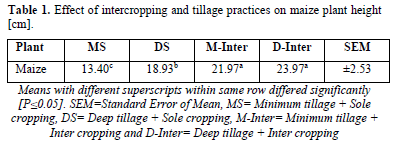
According to Table 2, there was a significant [P<0.05] difference in forage legume plant height derived from tillage and cropping techniques. Under deep tillage, soybean intercropped with maize resulted in to high plant height. On lablab grown as a sole crop under minimum tillage, the lowest plant height was recorded. The increased plant height may be due to improved soil texture by deep tillage which allows easy air circulation and nutrients for plant use. The findings of the present study differ from those of Belel [12] and Karanja [13], who suggested that the shade of the legume crop by the taller maize plants contributed to the decrease in terms of plant growth indices like plant height under intercropping system.
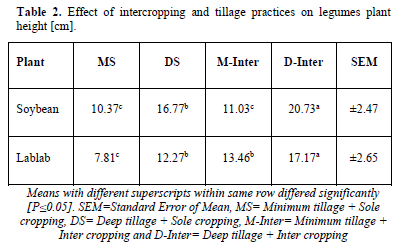
Table 3's display of maize plant density showed some significant [P<0.05] difference between treatments. On intercropped maize and legume fields with deep tillage, the highest plant density of maize was observed. The findings of this study are consistent with those of Shyamal and Bikas [3], who found a comparable pattern in increasing plant density of maize intercropped with a legume plant. Similar to this, greater plant numbers in maize intercropped with a soybean were also documented [12]. The results of this study, however, differed from those of Padhi and Panigrahi [14], who observed a declining trend in maize density with intercropped legume forage.
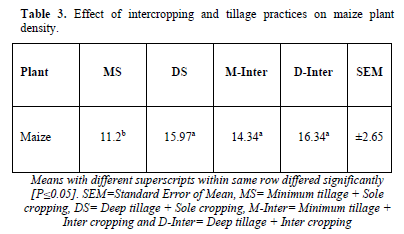
Forage legume plant densities were significantly different, as seen in Table 4. Highest plant density was recorded in legumes intercropped with maize under deep tillage. Under deep tillage, soybean had the highest plant density, followed by lablab, and both were intercropped with cereal plants. The lowest plant density for legumes was found in a lablab under sole cropping and minimum tillage. According to the current study's findings, deep-tilled soybean intercropped with cereal plants had maximum plant density. The results are consistent with those of Bagegnehu [1], who noted a rise in the number of legume plants intercropped with cereal maize. In a similar vein, Baldé [16] indicated that forage legumes intercropped with cereal maize resulted in to an increase in plant population.
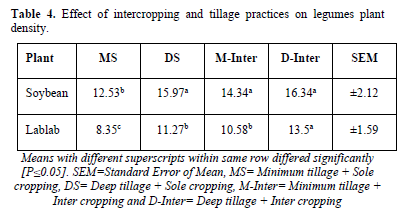
The length of the maize leaves differed significantly [P<0.05], although the length of the stems was not significantly different across all treatments, as shown in Table 5. Morphological characteristics of maize intercropped with selected forage legumes were highest under deep tillage, whereas sole maize under minimum tillage yielded the lowest leaf length. The findings of this study concur with those of Mucheru-Muna [17], who noted an increase in the morphological characteristics of maize intercropped with legume crops. Additionally, comparable findings were observed in studies by Leonard [18] and Shyamal and Bikas [3].
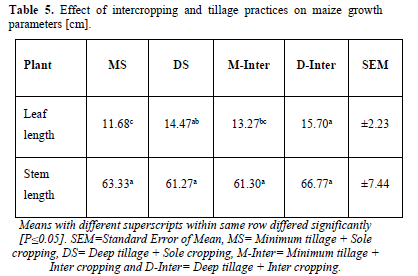
As shown in Table 6, the growth characteristics of forage legumes showed a substantial variation. Under deep tillage, where legumes were intercropped with maize, leaf length and stem length were found to be highest. The shortest stem length and leaves were found in the lablab under minimum tillage with sole cropping. Pretty and Bharucha [19] found that legumes intercropped with cereal had higher morphological characteristics, which is consistent with the findings of the current study. In a trial where legumes and cereal maize were intercropped, Eliakira [20] showed comparable outcomes with cereal maize intercropped with legumes.

CONCLUSION AND RECOMMENDATIONS
The development of cereal maize, soybeans, and lablab has been significantly impacted by cropping techniques and tillage depth in this study. In comparison to other treatments, the use of deep tillage with intercropping led to superior growth indices for cereal maize and forage legumes.
This method might be suggested as a successful agronomic strategy for smallholders during land preparation because the combination of deep tillage and intercropping shown the potential to boost the growth of maize and chosen forage legumes as a source of fodder for animals.
ACKNOWLEDGEMENTS
The authors gratefully acknowledge the Department of Animal Science at National University of Lesotho for making the study to be a success.
COMPETING INTERESTS
Authors have declared that no competing interests exist.
No Files Found
Share Your Publication :